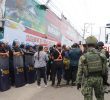By Ruell T. Garcia
It’s not about what you are thinking pre…hehehe!
Learning to “DUCK, COVER and HOLD“ is not enough.
The earthquake in Surigao City and Surigao del Norte was generated, according to Phivolcs, by the movement of the Philippine Fault System which traverses from the end point of Mindanao in Mati, Davao Oriental to the tip of Luzon, somewhere in the province of Pangasinan. The Mindanao Fault Zone of the Philippine Fault System cuts across Mati and Surigao, of course including the provinces, municipalities and barangays in between. All of these are product of the Philippines being part of the Pacific Ring of Fire.
Unfortunately, Compostela Valley is included. The municipalities hosting the fault line include Maragusan, New Bataan, Compostela (Barangays Gabi, Siocon, Aurora, Maparat), Monkayo, and some veins of the fault are found in Mawab and Nabunturan.
Experts in volcanology and seismology have repeatedly explained, unlike other hazards that pose potential possibility to become disasters, earthquake has no EARLY WARNING, it will strike at the most unexpected time. Unlike other hazards which assessment and analysis of vulnerability can project and estimate the vulnerable population and locations, in earthquake almost if not all people and locations are vulnerable depending on the generators, epicentre, magnitude and intensity.
Here’s my take:
- Consider the Surigao earthquake as early warning
- Educate, organize and mobilize people and communities in preparation of the unforeseen shaking anytime in the future, sooner, later or even none at all
- Formulate contingency plan (integrated and comprehensive) that is more or less realistic, practical and doable
- Give priority, in terms of resources and technical preparations, to barangays on top of the fault line
- Preposition goods, services and other logistical needs through MOA with legitimate suppliers
- Conduct drills not just for compliance but for real preparedness
- Formulate Preparedness Plan for business continuity
- Among others
The right time is now before it’s too late. A MUST: Institutionalization of Community-Based (Driven) Disaster Risk Reduction and Management.
Remember: Monkayo had experienced magnitude 7.2 sometime in 1893 (Cabanlit).
About the author: Ruell T. Garcia 41, is a freelance development worker and writer who believes in “thinking globally, acting locally”. He lives in Poblacion, Compostela, Compostela Valley with wife and children.




![[ANALYSIS] A different drug war](https://davaotoday.com/wp-content/uploads/2024/09/1000019103-110x100.png)





